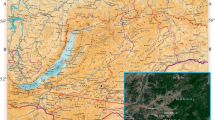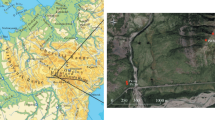Abstract
Soil studies were conducted in Southern Cisbaikalia. It has been established that climate and topography significantly affect the soil cover diversity and spatial distribution at the macro- and mesolevel. The complex geological structure, uneven age, and variety of bedrocks, as well as the composition and weathering degree of soil parent rocks, determine the distinct features of soils in the study area. As an example, the development of residual-calcareous brown forest soils is confined to outcrops of highly carbonaceous Cambrian rocks. At the microlevel, the soil cover structure is determined by the paleocryogenic Late Pleistocene microrelief. Its hummocky–pitted forms contribute to the differentiation of soil formation processes, thus, increasing the soil cover sophistication. Contrasting soil microcombinations are represented by complexes of automorphic autonomous soils on hummocky polygons and semihydromorphic heteronomous soils in cryogenic wedge-shaped structures (depressions). On hummocky polygons, the soil profile is formed in undisturbed ground masses, which is consistent with the postlithogenic soil formation type; while removals of the soil materials that occur on a regular basis indicate the denudation pedogenesis model. In depressions, the soil profile is formed in redeposited soil materials, while the presence of one or several buried humus horizons is consistent with the synlithogenic soil formation type and the accumulative–sedimentary (sedimentation) pedogenesis model. Based on the data collected in the course of this study, landscape and soil maps of Southern Cisbaikalia have been produced by interpolating the soil sampling points in the Quantum-GIS program with the application of landscape indication methods.




Similar content being viewed by others
REFERENCES
Aleksandrovskii, A.L. and Aleksandrovskaya, E.I., Evolyutsiya pochv i geograficheskaya sreda (Soil Evolution and Geographic Environment), Moscow: Nauka, 2005.
Targul'yan, V.O., Teoriya pedogeneza i evolyutsii pochv (The Theory of Pedogenesis and Soil Evolution), Moscow: GEOS, 2019.
Rol' pochvy v formirovanii i sokhranenii biologicheskogo raznoobraziya (The Role of Soil in the Formation and Conservation of Biological Diversity), Dobrovol’skii, G.V. and Chernov, I.Yu., Eds., Moscow: Tovarishchestvo Nauchn. Izd. KMK, 2011.
Krasilnikov P.V., Gerasimova, M.I., Golovanov, D.L., Konyushkova, M.V., Sidorova, V.A., and Sorokin, A.S., Pedodiversity and Its Significance in the Context of Modern Soil Geography, Eurasian Soil. Sci., 2018, vol. 51, pp. 1–13.
Toomanian, N., Pedodiversity and landforms, in Pedodiversity, Boca Raton: CRC Press, 2013, pp. 133–152.
Atlas. Irkutskaya oblast': Ekologicheskie usloviya razvitiya (Atlas. Irkutsk Oblast: Environmental Conditions of Development), Batuev, A.R., Ed., Moscow: Inst. Geogr. Sib. Otd. Ross. Akad. Nauk, 2004.
Kuz'min, V.A., Pochvy Predbaikal’ya i Severnogo Zabaikal’ya (Soils of Cisbaikalia and Northern Transbaikalia), Novosibirsk: Nauka, 1988.
Ekologicheski orientirovannoe planirovanie zemlepol’zovaniya v Baikal’skom regione. Ol’khonskii raion (Environmentally Oriented Land Use Planning in Baikal Region. Olkhonsky District), Antipov, A.N., Ed., Irkutsk: Inst. Geogr. Sib. Otd. Ross. Akad. Nauk, 2004.
Berkin, N.S., Filippova, S.A., Boyarkin, V.M., Naumova, A.M., and Rudenko, G.V., Irkutskaya oblast' (prirodnye usloviya administrativnykh raionov) (Irkutsk Oblast (Natural Conditions of Administrative Districts)), Irkutsk: Irkutsk. Univ., 1993.
Konovalova, T.I., Landscapes. Physical and geographical zoning, in Geograficheskaya entsiklopediya Irkutskoi oblasti. Obshchii ocherk (Geographical Encyclopedia of Irkutsk Oblast. General Outline), Irkutsk: Inst. Geogr. Sib. Otd. Ross. Akad. Nauk, 2017, pp. 84–89.
Belov, A.V., Lyamkin, V.F., and Sokolova, L.P., Kartograficheskoe izuchenie bioty (Cartographic Research of Biota), Irkutsk: Oblmashinform, 2002.
Sokolov, I.A., Teoreticheskie problemy geneticheskogo pochvovedeniya (Theoretical Problems of Genetic Soil Science), Novosibirsk: Gumanit. Tekhnol., 2004.
Shishov, L.L., Tonkonogov, V.D., Lebedeva, I.I., and Gerasimova, M.I., Eds., Klassifikatsiya i diagnostika pochv Rossii (Classification and Diagnostics of Soils in Russia), Smolensk: Oikumena, 2004.
Landsat Look Viewer. http://landsatlook.usgs.gov/ viewer.html. Accessed August 22, 2019.
SRTM Tile Grabber. http://dwtkns.com/srtm/. Accessed September 5, 2019.
Teoriya i praktika khimicheskogo analiza pochv (Theory and Practice of Chemical Analysis of Soils), Vorob’eva, L.A., Ed., Moscow: GEOS, 2006.
Chichagova, O.A., Khokhlova, O.S., Zazovskaya, E.P., and Goryachkin, S.V., Radiocarbon analysis and problems of soil memory, in Pamyat’ pochv. Pochva kak pamyat' biosferno-geosferno-atroposfernykh vzaimodeistvii (Soil Memory. Soil as Memory of Biosphere-Geosphere-Atropospheric Interactions), Moscow: LKI, 2008, pp. 182–203.
Karta pochvenno-geograficheskogo raionirovaniya SSSR (dlya vysshikh uchebnykh zavedenii) m-ba 1 : 8 000 000 (Map of Soil-Geographical Zoning of the USSR (for Higher Educational Institutions), Scale 1 : 8 000 000), Dobrovol’skii, G.V., Rozov, N.N., Urusevskaya, I.S., Eds., Moscow: Mosk. Univ., 1983.
Belozertseva, I.A., Soil cover, in Geograficheskaya entsiklopediya Irkutskoi oblasti. Obshchii ocherk (Geographical Encyclopedia of Irkutsk Oblast. General Outline), Irkutsk: Inst. Geogr. Sib. Otd. Ross. Akad. Nauk, 2017, pp. 50–55.
Ubugunov, L.L., Ubugunova, V.I., Belozertseva, I.A., Gyninova, A.B., Sorokovoi, A.A., and Ubugunov, V.L., Soils of the Lake Baikal Drainage Basin: Results of research for 1980–2017, Geogr. Nat. Resour., 2018, vol. 39, pp. 332–342.
Belozertseva, I.A., Ubugunov, L.L., Badmaev, N.B., Ubugunov, V.L., Dorzhgotov, D., Batkhishig, O., Ubugunova, V.I., Gyninova, A.B., Balsanova, L.D., Gonchikov, B.N., Tsybirdorzhiev, Ts.D.-Ts., and Sorokovoi, A.A., Karta “Pochvy basseyna ozera Baykal”. M-b 1 : 2 500 000 (Map of Soils of the Lake Baikal Basin. Scale 1 : 2 500 000), Irkutsk: Inst. Geogr. Sib. Otd. Ross. Akad. Nauk, 2015. https://elibrary.ru/item.asp? id=24268323. Accessed September 5, 2019.
Semenov, Yu.M., Smolentsev, B.A., Desyatkin, R.V., Semenova, L.N., and Belozertseva, I.A., Soil cover, in Priroda. Seriya monografii “Geografiya Sibiri v nachale XXI veka” (Nature. Series of Monographs “Geography of Siberia in the Early 21st Century”), Irkutsk: Inst. Geogr. Sib. Otd. Ross. Akad. Nauk, 2015, vol. 2, pp. 206–231.
Vorob’eva, G.A., Evolution of soils in the foothills and low mountains of the south of Central Siberia in the Holocene, in Evolyutsiya pochv i pochvennogo pokrova. Teoriya, raznoobrazie prirodnoi evolyutsii i antropogennykh transformatsii pochv (Evolution of Soils and Soil Cover. Theory, Diversity of Natural Evolution and Anthropogenic Soil Transformations), Moscow: GEOS, 2015, pp. 686–703.
Friedland, V.M., Struktura pochvennogo pokrova (The Structure of the Soil Cover), Moscow: Mysl, 1972.
Belov, A.V. and Sokolova, L.P., Geobotanical forecasting in the nature management ecological optimization in Baikalian Siberia, Geogr. Prir. Resour., 2017, vol. 38, pp. 38–45.
Zonn, S.V., Zhelezo v pochvakh (Iron in Soils), Moscow: Nauka, 1982.
Kozlova, A.A., Kuz’min, V.A., and Zazovskaya, E.P., Soils of paleocryogenic hummocky-hollow landscapes in the southern Baikal region, Eurasian Soil. Sci., 2014, vol. 47, pp. 360–370.
Funding
This work is done within the state task SB RAS (number of the project registration AAAA-A21-121012190055-7, AAAA-A19-119080700040-8) and with the financial support from the Russian Foundation for Basin Research for the scientific projects (no. 19-55-44020 Mong_t).
Author information
Authors and Affiliations
Corresponding authors
Ethics declarations
Conflict of Interest
The authors declare that they have no conflict of interest.
Additional information
Translated by L. Emeliyanov
Rights and permissions
About this article
Cite this article
Kozlova, A.A., Belozertseva, I.A. & Lopatina, D.N. Soils of Southern Cisbaikalia: Diversity and Spatial Distribution Patterns. Geogr. Nat. Resour. 42, 58–70 (2021). https://doi.org/10.1134/S1875372821010091
Received:
Revised:
Accepted:
Published:
Issue Date:
DOI: https://doi.org/10.1134/S1875372821010091




